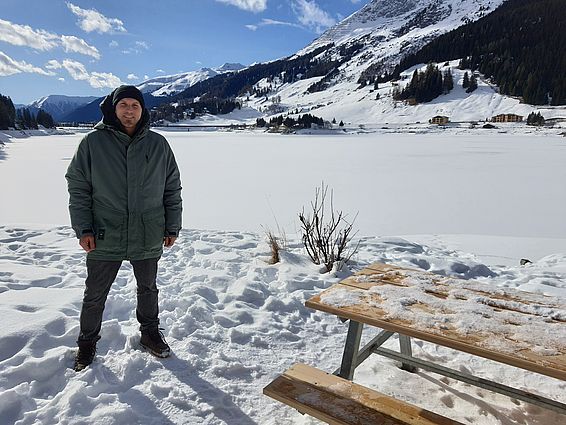Johan Gaume is head of the new research group alpine mass movements at the WSL Institute for Snow and Avalanche Research SLF at Davos. On a walk around lake Davos, he speaks about his scientific work, particularly exciting moments and about his plans for his group.
The SLF showcases the research groups of the Climate Change, Extremes and Natural Hazards in Alpine Regions Research Centre CERC, in no particular order. Founded in 2021, the CERC is sponsored by the Canton of Grisons and the Swiss Federal Institute for Forest, Snow and Landscape Research WSL and is supported by ETH Zurich. It is part of the SLF in Davos.

Johan, You are modelling alpine mass movements, but how?
We use a rather unconventional approach. Most approaches for mass movements are working in 2D. These methods, introduced around 40 years ago, are fast to run but also have limitations. In our group, we are developing and using 3D models for most of them based on the Material Point Method, or MPM, a hybrid numerical technique mostly used in geomechanics and graphics. After my PhD, I was convinced it could be groundbreaking in avalanche research.
But You had problems with the funding.
Yes, I submitted many proposals which were all rejected. But I was really stubborn (laughs) and decided to go to the US to collaborate with MPM experts. The work we did proved the promise of the approach and then the funding followed! We are now extending this model to other materials and develop the next generation of models for mass movements. Our code is well suited to simulate interactions of mass movements with obstacles, for example. And so, it could be used in the future to evaluate pressures on galleries or to design dams, mitigation measures for debris flows, for rock, ice and snow avalanches.
What was Your most astonishing scientific result?
The most recent one was about crack propagation in snow slab avalanche release. After running simulations at a scale larger than usual, we got surprised: the fracture speed in the weak layer was much larger than any measurements performed so far. We thought we had a problem with our code! But we didn’t and we eventually made sense of what was going. The nice thing is that this result unified conflicting theories with important practical impacts. I really love those unintentional “Wooaa” moments, when after months of struggle, you get a flash and finally get it! That’s one of the reasons I am doing this job and keep pushing!
We talked a lot about modeling, do you plan to do experiments as well.
Yes, we will also perform experiments. For instance, we will soon acquire a large-scale 3D printer to perform granular flow experiments over complex 3D printed terrain. This will allow us to improve our understanding of granular flows and their interaction with different topographical features, and also to gather data for model validation!
Do you also get external funding?
Until now, most of my research has been funded by the Swiss Government and the Swiss National Science Foundation. So I take the opportunity to thank them one more time for supporting my ideas, especially the crazy ones, which other agencies where reluctant to fund and which led to some of my best research!
Will Your new job as professor and group leader leave You with enough time for research?
I will have a lot of management and administration to do, but we will soon get administrative support. This will let me focus more on the scientific content, supervision and teaching, and hopefully, I’ll still find some time to code and write papers!
So Your group will grow?
We are currently hiring and we should have around 10 people this summer. I will also submit a large proposal this year. If accepted, we will hire a few more scientists. We will also open a spinoff company which will be active in consulting and developing software and services for practitioners… busy times ahead of us!
Contact ¶
Links ¶
Copyright ¶
WSL and SLF provide the artwork for imaging of press articles relating to this media release for free. Transferring and saving the images in image databases and saving of images by third parties is not allowed.

